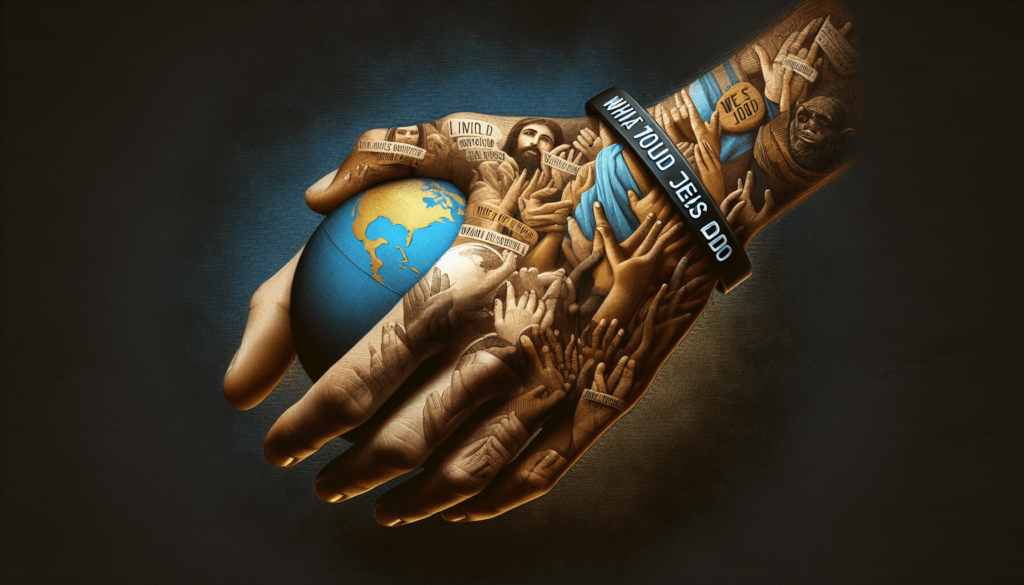Imagine sporting a simple bracelet that does more than just accessorize your outfit. It serves as a constant reminder of an essential question: What Would Jesus Do? This concept took the world by storm in the 1990s, transforming from a personal reflection into a widespread cultural phenomenon. WWJD bracelets, stemming from a desire to promote Christian values in daily decision-making, quickly became a popular trend. They offered wearers a tangible way to keep moral considerations at the forefront of their minds. As you delve into the cultural impact of these bracelets, you’ll uncover not only why they gained popularity but also how they have continued to influence both personal behavior and broader societal discussions to this day.

Brief History of WWJD Bracelets
The WWJD (What Would Jesus Do?) bracelets are more than just a fashion statement; they represent a significant part of Christian culture, reminding wearers of the moral and ethical question that aims to align personal actions with the teachings of Jesus Christ.
The conception of the bracelets
The concept of WWJD can be traced back to the book “In His Steps: What Would Jesus Do?” written by Charles Sheldon in 1896. However, the bracelets themselves didn’t become a tangible item until the 1990s. The idea was to carry the powerful question with you, serving as a constant reminder of one’s faith and the choices they make daily.
Prominent figures who popularized them
While no single figure can be credited with the rise of WWJD bracelets, their popularity soared due to endorsements from Christian leaders and figures in the Christian community who embraced and promoted the message. Their visibility on the wrists of public figures played a significant role in their initial popularity.
The rise in popularity during the 1990s
In the 1990s, WWJD bracelets exploded onto the scene as a significant trend within the Christian community and beyond. They were more than just accessories; they symbolized a widespread adoption of the principle behind the question, “What Would Jesus Do?” This era marked the peak of their popularity, as young and old alike used these bracelets as a tool to reflect on their actions in a Christian light.
Influence on Christian Youth
Beyond their aesthetic appeal, WWJD bracelets have had a profound impact on Christian youth, serving multiple significant purposes.
Use as a constant reminder of religious teachings
For young Christians, these bracelets acted as a continual nudge towards self-reflection on their actions and decisions, asking themselves how they align with the teachings of Jesus. It became a personal check-and-balance for living out their faith.
A tool for promoting Christian values among peers
Wearing a WWJD bracelet was also a form of evangelical tool, a conversation starter that allowed young believers to discuss their faith with peers in a non-confrontational way. It helped in promoting Christian values subtly yet effectively.
Symbol for personal commitment to the Christian faith
For a lot of youths, the bracelet became a symbol of their personal commitment to Christianity. It represented a conscious decision to try and live by what they believed Jesus would do in their place, fostering a deeper connection to their faith.
Popularity in Modern Pop Culture
WWJD bracelets have also found their way into the broader pop culture, far beyond their initial religious contexts.
Influence in modern music and movies
The message of WWJD has been referenced in songs and movies, often used to reflect a character’s moral dilemma or personal growth. This crossover underlines the universal appeal of considering one’s actions carefully.
Integration into fashion trends
WWJD bracelets became an accessory that could be seen on the wrists of celebrities, further fueling their popularity as a fashion trend. They have been designed in various styles to match different tastes, integrating seamlessly into broader fashion trends.
Impact in social media platforms
In the era of social media, WWJD bracelets have found a new avenue for influence. Posts, hashtags, and discussions around WWJD serve to keep the conversation going, making the message as relevant today as it was decades ago.
Interpretation and Misinterpretation of the WWJD Message
The message behind WWJD is profound, yet its interpretation has been a subject of both inspiration and controversy.
Understanding the true essence of WWJD
The true essence of WWJD rests in its call to live a life reflective of Jesus Christ’s teachings and actions, emphasizing love, kindness, and humility. It encourages individuals to pause and consider the moral and ethical implications of their actions.
Debates on interpretations of WWJD
However, the simplicity of the question has led to varied interpretations, with debates arising over how best to mirror Jesus’s actions in complex, modern situations. These discussions are often healthy, driving deeper engagement with Christian teachings.
Misinterpretation and misuse of the WWJD message
Sometimes, the WWJD message has been misused as a way to judge others’ actions rather than reflect on one’s own. This misinterpretation misses the mark entirely, shifting focus from self-improvement to casting judgment.

WWJD Bracelets as Accessories
Despite their deep religious connotations, WWJD bracelets have been embraced broadly as fashionable accessories.
Popularity among different age groups
Their appeal spans across different age groups, from young children to adults, showcasing the timeless aspect of the message and its relevance regardless of age.
Variations in style and design of the bracelets
To cater to varying tastes, these bracelets have been made in many styles and designs, utilizing different materials, and sometimes even incorporating other symbols or messages alongside the central WWJD question.
Accessibility and affordability factors
One of the reasons for the widespread popularity of WWJD bracelets is their accessibility and affordability. They can be found in many stores, online platforms, and can even be handmade, making them accessible to a wide audience.
Criticism of WWJD Bracelets
Like any popular movement, WWJD bracelets have not been without their critics.
Views regarding the commercialization of religion
Critics argue that the commercial aspect of selling WWJD-branded merchandise risks trivializing the deeper religious message, turning it into a commodity rather than a sincere religious expression.
People using WWJD as a trend, not a religious commitment
There’s also the concern that for some, wearing a WWJD bracelet is more about following a trend than about a genuine commitment to living out Christian values.
Negative feedback on quality of some bracelets
As with any popular item, quality can vary, and there have been complaints regarding the durability and quality of some WWJD bracelets, which can detract from the message they are meant to carry.

WWJD Bracelets: Trend and Beyond
The journey of WWJD bracelets from a trend to a personal symbol elucidates their lasting impact.
Transition from trend to personal symbol
While initially a widespread trend, over time, WWJD bracelets have become more of a personal symbol for many, representing an individual’s commitment to their faith and values.
How the significance has changed over time
The significance of WWJD bracelets has evolved, with many now viewing them not just as reminders for personal reflection, but as symbols of hope, unity, and a beacon for living a life guided by love and compassion.
Current relevance of WWJD bracelets
Today, WWJD bracelets remain relevant, continually finding new audiences and serving as a bridge for conversations about faith, morality, and the choices we make every day.
Impact on Other Religious Movements
The phenomenon of WWJD bracelets has had a ripple effect, even beyond Christianity.
Inspiration for similar religious accessories in other faiths
The concept has inspired similar movements and accessories in other faiths, creating avenues for followers to carry a piece of their religious teachings with them as a reminder and symbol.
Influence on religious movements outside Christianity
The success and impact of WWJD bracelets have shown how a simple concept can mobilize and engage followers, influencing how other religious movements think about engagement and expression.
Role of WWJD bracelets in interfaith dialogues
They have also played a role in interfaith dialogues, serving as a conversation starter on common ground between different faiths, centered on living a life of good deeds and moral integrity.
Non-Christian Perspective on WWJD Bracelets
The appeal of WWJD bracelets has transcended Christian communities, finding acceptance and respect among people of various faiths.
Acceptance and respect among other faiths
Many non-Christians view the message of WWJD as universal, appreciating the emphasis on self-reflection and moral consideration, leading to respect and acceptance of the bracelets as a positive symbol.
Utilization in promoting peace and unity
In some cases, the WWJD message has been utilized in broader efforts to promote peace, unity, and understanding across different religious and cultural divides, showcasing its universal relevance.
Misunderstandings and controversies
However, there have been misunderstandings and controversies, especially when the message is perceived as exclusive or judgmental. These instances underscore the importance of context and intention in the message’s interpretation.
WWJD Bracelets in Philanthropy and Charity
The influence of WWJD bracelets extends into philanthropy and charity, highlighting their impact on broader humanitarian efforts.
Use in fundraising activities
WWJD bracelets have been used in numerous fundraising activities, with proceeds going to support various charitable causes. This has added another layer of significance to the bracelets, linking them to acts of generosity and kindness.
Success stories of charities supported by WWJD sales
There are many success stories where sales from WWJD bracelets have significantly supported charities, from local community projects to international humanitarian missions, showcasing the tangible impact of these small accessories.
Impact on charitable and humanitarian efforts globally
The global impact of these efforts cannot be overstated, as funds raised through WWJD bracelets have contributed to bettering lives, supporting the needy, and funding vital projects around the world, thus living out the very essence of the WWJD question.


Latest Comments